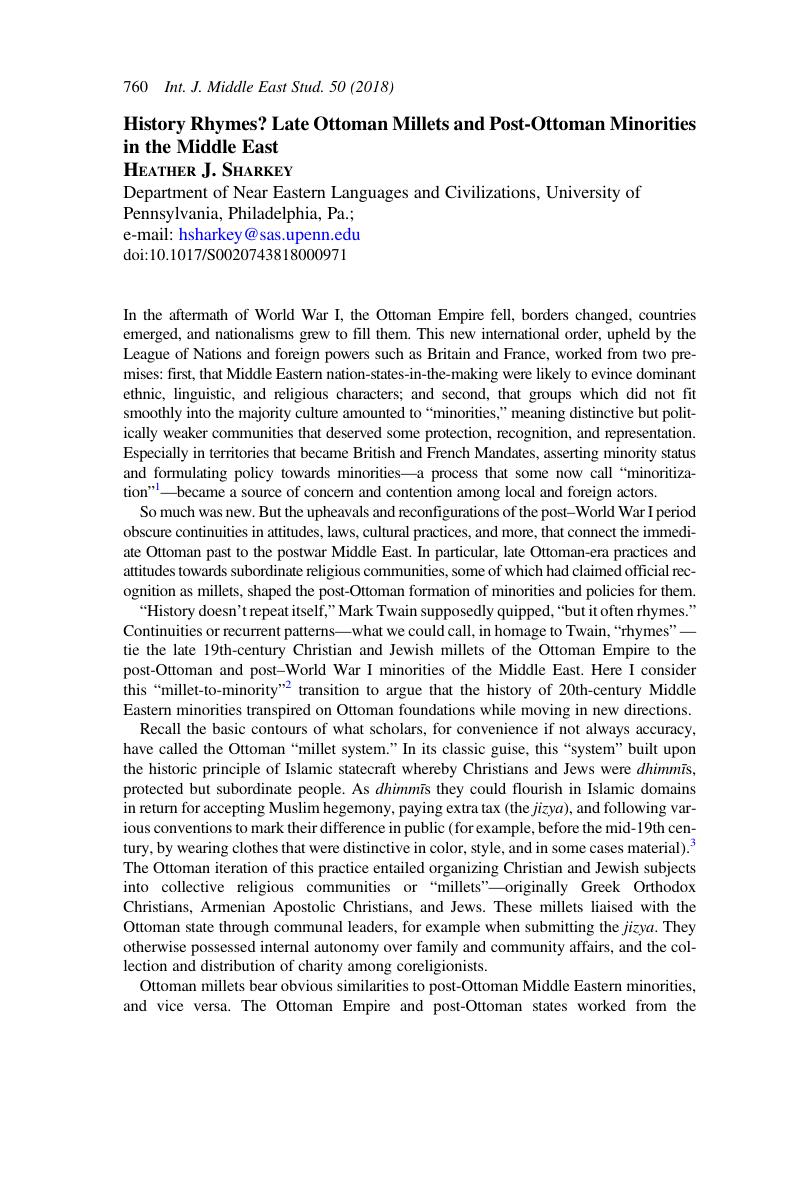Article contents
History Rhymes? Late Ottoman Millets and Post-Ottoman Minorities in the Middle East
Published online by Cambridge University Press: 28 November 2018
Abstract

- Type
- Roundtable
- Information
- Copyright
- Copyright © Cambridge University Press 2018
References
NOTES
1 Robson, Laura, ed., Minorities and the Modern Arab World (Syracuse, N.Y.: Syracuse University Press, 2016)Google Scholar.
2 See, for example, Peter Sluglett, “From Millet to Minority: Another Look at the Non-Muslim Communities in the Late Nineteenth and Early Twentieth Centuries,” in Minorities and the Modern Arab World, 32.
3 Sharkey, Heather J., A History of Muslims, Christians, and Jews in the Middle East (Cambridge: Cambridge University Press, 2017)CrossRefGoogle Scholar.
4 Braude, Benjamin, “Foundation Myths of the Millet System,” in Christians and Jews in the Ottoman Empire, ed. Braude, Benjamin and Lewis, Bernard (New York: Holmes and Meier, 1982), 1:69–88Google Scholar; Masters, Bruce, “Christians in a Changing World,” in The Cambridge History of Turkey, vol. 3, The Later Ottoman Empire, 1603–1839, ed. Faroqhi, Suraiya N. (Cambridge: Cambridge University Press, 2006), 272–79CrossRefGoogle Scholar.
5 Berkes, Niyazi, The Development of Secularism in Turkey (Montreal: McGill University Press, 1964), 326–27Google Scholar.
6 Masters, Bruce, Christians and Jews in the Ottoman Arab World: The Roots of Sectarianism (Cambridge: Cambridge University Press, 2001), 106–16Google Scholar.
7 Zürcher, Erik J., Arming the State: Military Conscription in the Middle East and Central Asia, 1775–1925 (London: I.B.Tauris, 1999), 88–89Google Scholar.
8 Ortaylı, Ilber, “Les groupes hétérodoxes et l'administration ottoman,” in Syncretistic Religious Communities in the Near East, ed. Kehl-Bodrogi, Krisztina, Kellner-Heinkele, Barbara, and Otter-Beaujean, Anke (Leiden: Brill, 1997), 205–11Google Scholar.
9 Thio, Li-Ann, Managing Babel: The International Legal Protection of Minorities in the Twentieth Century (Leiden: Brill, 2005)Google Scholar.
10 White, Benjamin, “The Nation-State Form and the Emergence of ‘Minorities’ in Syria,” Studies in Ethnicity and Nationalism 7 (2007): 64CrossRefGoogle Scholar.
11 Hourani, Albert, Minorities in the Arab World (Oxford: Oxford University Press, 1947)Google Scholar.
12 Alda Benjamen, “Assyrians and the Iraqi Communist Party: Revolution, Urbanization, and the Quest for Equality,” in Minorities in the Arab World, 106–21.
13 Robson, introduction to Minorities in the Arab World, 1–16.
14 White, “The Nation-State Form,” 70–71.
15 Rodrigue, Aron, “Reflections on Millets and Minorities: Ottoman Legacies,” in Turkey between Nationalism and Globalization, ed. Kastoryano, Riva (London: Routledge, 2013), 36–46Google Scholar.
16 White, Benjamin Thomas, The Emergence of Minorities in the Middle East: The Politics of Community in French Mandate Syria (Edinburgh: Edinburgh University Press, 2011), 59CrossRefGoogle Scholar.
17 Reynolds, Michael A., Shattering Empires: The Clash and Collapse of the Ottoman and Russian Empires, 1908–1918 (Cambridge: Cambridge University Press, 2011)CrossRefGoogle Scholar. See, e.g., p. 51.
18 Heyberger, Bernard, Les Chrétiens d'Orient (Paris: Presses universitaires de France, 2017)Google Scholar.
19 Shafir, Gershon and Peled, Yoav, Being Israeli: The Dynamics of Multiple Citizenship (Cambridge: University of Cambridge Press, 2002)CrossRefGoogle Scholar.
20 On the salience of religion in European understandings of minorities, see Henrard, Kristin, The Ambiguous Relationship between Religious Minorities and Fundamental (Minority) Rights (The Hague: Boom Eleven International, 2011)Google Scholar.
- 3
- Cited by


